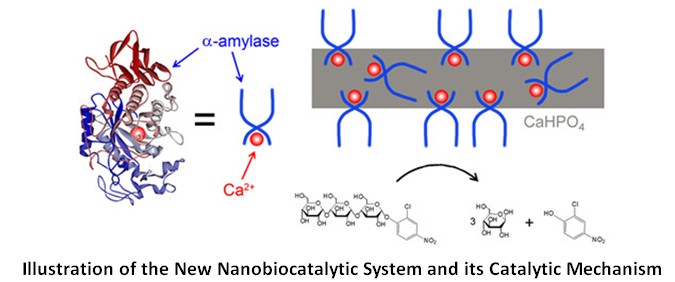Important Progresses in Designing Hybrid Nanostructures and Catalysis
Recently, the research group led by Prof. ZENG Jie invented a new nanobiocatalytic system based on allosteric effect. This progress has been published in J. Am. Chem. Soc. 2013, 135, 1272. The first author of the work is Liang-Bing Wang, a senior undergraduate student of the Department of Chemistry of USTC.
Hybrid nanostructures have been found to exhibit desiring catalytic performances due to synergistic effects. Thus, controllable synthesis of them has attracted ever increasing attention from the most active physical chemists and materials scientists. Inspired by the allosteric effect of enzymes, the researchers in Prof. ZENG Jie's group designed a new nanobiocatalytic system, which contained a rational design of CaHPO4-α-amylase hybrid nanostructures. Through studying enzymatic performance of these systems, they demonstrated how two factors, allosteric regulation and morphology of the nanostructures, predominantly influence enzymatic activity. Benefiting from the synergistic effect between the allosteric modulation and the hierarchical nanostructure, CaHPO4-α-amylase hybrid nanoflowers exhibited dramatically enhanced enzymatic activity, stability, and durability. The new nanobiocatalytic system is promising to find widespread use in applications related to biomedicine, biofuel cells, biosensor, and issue engineering.

Prof. ZENG Jie took the faculty position at the School of Chemistry and Materials Science of USTC in early 2012. His research interests include shape-controlled synthesis, heterogeneous catalysis, and plasmonics. The research in his group involves interdisciplinary projects covering chemistry, physics, materials science and biology, aiming at both fundamental and applicable studies. Since his resumption at the School of Chemistry and Materials Science, he has published an article entitled “Symmetric and asymmetric Au-AgCdSe hybrid nanorods” (Nano Lett. 2012, 12, 5281). He was also invited to write a review about recent progress of hybrid nanomaterials for Nature Nanotechnology (Nature Nanotech. 2012, 7, 415). For more information, please visithttp://zengnano.ustc.edu.cn/.
These works were supported by the Recruitment Program of Global Experts, the National Natural Science Foundation of China (NSFC), and the CAS Hundred Talent Program.
Back
